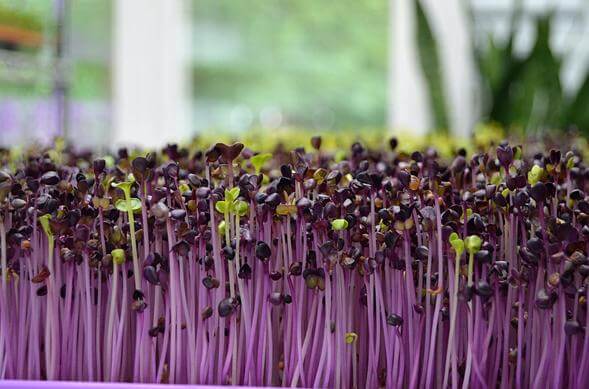From a few herbs perched on a sunny windowsill to a full vegetable garden in a purpose-built indoor grow room — do you grow vegetables indoors? From easy to grow greens to herbs to tomatoes, there is a lot to be said about growing your own indoor veggies.
What vegetables are best to grow indoors? Technically, with the right equipment and cultivation know-how, almost any fruit or vegetable can thrive in an indoor environment. But, some are easier than others, especially if you don't have a green thumb. What are the easiest vegetables to grow indoors? Let's cover the go-to veggies you'll want to get started with.
Microgreens
Ideal Light Exposure: Window sill with full to partial sun, or grow light. Typically, they require six to ten hours of light a day.
Microgreens are one of the simplest vegetables to grow inside, with minimal experience and even less equipment.
Microgreens are harvested long before they need substantial root development. Therefore you can use just about any shallow container to get started. A thin layer of soil (or pad), a sunny window sill, a dense sprinkle of seeds, and within a week, you'll have fresh nutrient-dense microgreens ready to harvest.
Microgreens include peas, broccoli, alfalfa, and more. Many pantry-staples you have in your cupboard are enough to get started, including beans, barley, lentils, and other legumes. If you don't have much gardening experience, get started growing indoors with microgreens.
Fine Herbs Like Chives, Basil, Cilantro, and Parsley
Ideal Light Exposure: South facing window or grow light. It requires six to ten hours of light a day.
Fresh leafy culinary herbs often do well in bright windows and under small tabletop grow lights. Herbs like basil, chives, parsley, and cilantro are all easy to grow and do well in small pots. Plus, it is usually only a few weeks before you can start harvesting. Some herbs, like basil, can provide an indefinite harvest all year round. Plus, you can always air dry for long term storage.
Lettuce and Greens
Ideal Light Exposure: South facing window during summer months, or grow light during cooler months. Lettuce requires between ten to 12 hours of light a day.
Ready to eat greens make salads all the more enjoyable, especially in January. During the longer days of summer, it is possible to grow lettuce in a bright window sill, but during the shorter days of winter, you'll need a small grow light to provide enough exposure.
With a shallow garden tray and rich premixed soil, you'll have baby greens ready to eat within a month (or full heads within two months). All varieties of lettuce transition well from an outdoor garden into an indoor grow setup.
Tomatoes, Peppers and Night Shades
Ideal Light Exposure: Indoor Grow lights, Minimum eight-hour exposure.
Have you ever experienced the flavor bomb of a fresh garden tomato? It's the only argument you need to set up a grow tent or transform a little-used corner of your storage room into an indoor garden. In fact, all nightshades, like peppers and eggplants, make for great indoor vegetables. Unlike other veggies on this list, tomatoes, peppers, and eggplants do best with grow lights, and in a space where you have total temperature control. To produce fruit, the plants will need a minimum of eight hours of light a day and 65 degrees F (18 degrees C) climate. Bigger harvest and certain species may need even longer light exposure and temperatures to create the ideal outdoor climate, inside. Hence, why a grow tent makes sense.
Strawberries
Ideal Light Exposure: Grow lights. Strawberries require at least eight to ten hours of light to produce fruit.
Are you looking for a sweet treat to add to your indoor garden? Strawberries are an attractive addition because of their tiny size and simple requirements. They thrive in small containers, which is a bonus for indoor growing.
Although bright sunny south-facing windows might work during some months of the year, ideally you'll want strawberries in the depths of winter. A small, grow light system will be enough to supply several plants with the light they need to produce deep red fruits. Remember, strawberries will require hand pollination if grown indoors.
Grow Vegetables Indoors for Year-Round Harvests
The best vegetables to grow indoors light small spaces, have minimal environmental needs, and may even thrive in a window sill. Microgreens, lettuce, and leafy herbs are the easiest indoor vegetables. They require little equipment and little skill but excellent fresh harvests. Even on a bright sunny window, they can thrive with year-round harvests.
Stepping it up a notch (but only slightly), an indoor grow light pumps out a fresh supply of tomatoes, peppers, and eggplants. That means fresh produce even in the darkest months of winter.





